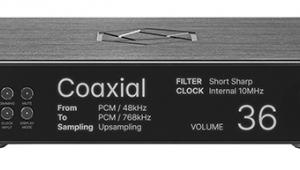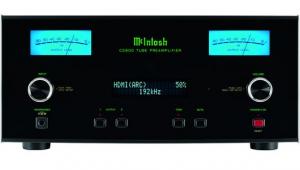Bel Canto Dac3 (£1999)
When I reviewed the CD-2 CD transport/player last year [HFN, April ’08], I liked its clean, smooth sound quality, especially when set to the internal DAC’s native 24-bit/192kHz rate. Although a CD player, it is principally intended as a transport (being built around a high-quality Pro2 CD mechanism). The DAC chip included, while good, is not a high-end device, yet Bel Canto managed to extract a very pleasing performance from it. I wondered what Bel Canto could do given a bigger budget for the processing and analogue circuits.
The DAC3 is just that, claiming to deliver a ‘new standard of subjective and measured performance’ and includes a 24-bit ‘digital preamp’ with integral dithered digital volume control. The package is much the same as the CD-2, with the same ‘footprint’, pressed steel lid, chunky anodised aluminium front panel, with single rotary knob user interface and green status display. The volume is operable directly via this knob, or the remote, rather like a preamp, albeit one with five digital-only inputs. Alternatively, the output may be fixed for use with a preamp. Both unbalanced RCA and balanced XLR outputs are provided [see picture, top right].
THE JITTER BUG
The DAC3 includes two PLLs (Phase-Locked Loop) to reduce incoming jitter while an asynchronous sample rate converter re-configures 16-bit data to 24-bit/192kHz, using linear phase interpolation filters. These are claimed to avoid introducing spurious signals, preserve wave-shapes and avoid spoiling harmonic relationships with higher frequency musical signals.
For this outboard device, Bel Canto has selected an upmarket 24-bit/192kHz DAC from Burr-Brown which offers a superior performance to the lower cost Crystal DAC used in the CD-2 player. This, and the digital filter, have a claimed near-24-bit noise and linear phase, while the I-to-V section uses fully balanced Class A op-amps boasting a 90MHz bandwidth. The low-pass analogue filter is way out at 100kHz, with slow roll-off to minimise phase distortions within the audioband.
Bel Canto claims that many factors contribute to the sound quality of its DAC3, including the multi-layer printed circuit board, isolated analogue and digital sections, low noise isolated power supplies, isolated inputs and stable low-noise ‘Ultra-Clock’ circuit.
Like the CD-2, I found the DAC3 quite easy to use, once the peculiarities of the single knob control were mastered. They look great together, especially with modern furniture, where their clean and simple lines seem to blend in particularly well. Bel Canto also supplies the same remote control with both products, although few of its functions refer directly to the DAC3.
CLARITY
Firstly, let’s be clear: I like the sound of the DAC3. It is sweet and smooth, clear and spacious. It is not vinyl, not pure analogue, but it definitely has more of the analogue than the digital about it. Yet, it is not over-smooth, or in any way lacking in detail.
Straight out of the box, the DAC3 sounds fluid and transparent in a disarmingly non-electronic way, without even a hint of added harshness, artificial edge or grain. Compared with the CD-2 on its own, the DAC3 surprised me with its extra transparency, separation and realism. For instance, I listened to Mozart’s Clarinet Concerto K622 played by Gervaise De Peyer, and the London Symphony Orchestra [Ovation CD Decca 417-759-2].
De Peyer’s clarinet sounded rich and silky smooth, the strings nicely textured, and tonally very pleasing with no hint of edginess. The acoustics were conveyed well and even the rumbling trains captured by the microphones in this 1959 Kingsway Hall recording were reproduced with the same disarming transparency!
Coincidentally, the next recording, of John Coltrane was also made in 1959 [Coltrane Jazz, Atlantic 7567-81344-2]. OK, so the recording may be limited in bandwidth compared to modern offerings, but the DAC3 replayed Coltrane’s sax on ‘I’ll wait and pray’ with sympathetic warmth and richness while the string bass, drums and lightly brushed cymbals were all presented quite naturally in an understated but delightfully transparent fashion.
Stepping forward to a more modern recording, I played the CD layer of Soul Survivor (The best of Mighty Sam McClain on Audioquest AQ SACD1053). Sam’s vocals were well to the fore, cymbals were crisp and metallic, the guitar was sharp and aggressive and cymbals rang clearly. So, the DAC3 has clarity and resolution, even aggressiveness and attack if required.
Finally, there was Duffy’s Rockferry. Here was a big, spacious sound. With its Motown meets Phil Spector influences, the music fairly belted from the speakers. Yet Duffy’s smooth, sexy voice was projected clearly and well focused. This is a modern, crisp and vividly etched recording and the DAC3 shows that, from jangling guitars to syrupy strings. It is just like an open window, neither emphasising nor suppressing.
A FLIRTATION WITH USB
All my listening impressions were made courtesy of the S/PDIF BNC input which I hooked-up using Analysis Plus Digital Oval interconnect cables (loaned by Bel Canto’s UK distributor Aanvil Audio), which helped the CD-2 and DAC3 in delivering its transparent sound.
Apart from the S/PDIF input used for the main listening, there was also the USB, which more enthusiasts are using these days to replay music files from a server or other archive. I briefly tested the USB input by playing Duffy’s Rockferry directly from the hard drive on my laptop. Apart from the occasional signal drop-out from my PC, the USB interface with its input transformers and two-stage jitter reduction made a fair job of translating this into music. On the other hand, the end result was not so transparent, alive or detailed as via the S/PDIF datastream from the CD-2. So, unsurprisingly, the USB option would not be my first choice of inputs. Via the other inputs however, the sound was quite simply delightful.
VERDICT
The DAC3 turns in a subtly natural performance, which suits all kinds of music. Its smooth delicate delivery and broad, deep sound spread are a delight, with more than a hint of analogue about it. The DAC3 is quite simply transparent, but maybe not so suited to ‘head-bangers’, or those who seek a permanently crisp and impressive up-front reproduction.
Originally published in the January 2009 issue



















































